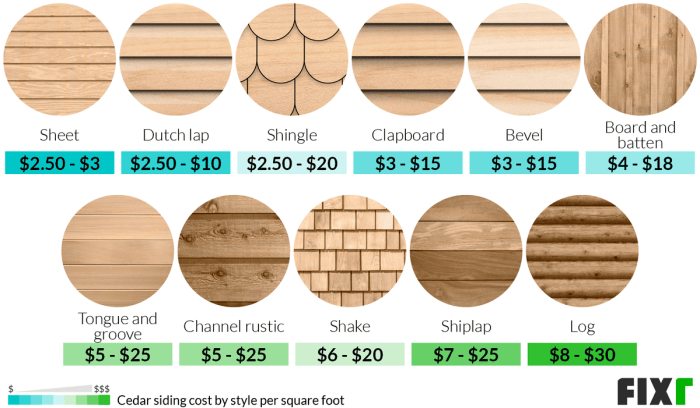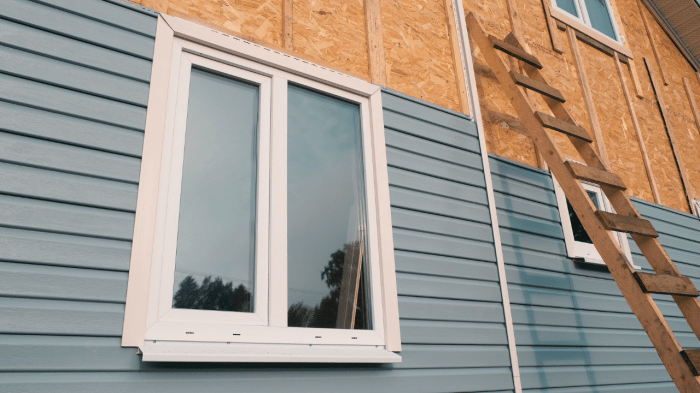Insulated siding cost per square foot: It’s a question homeowners ask themselves before embarking on a home improvement project that promises both beauty and energy efficiency. But the answer isn’t a simple number. The cost varies wildly depending on factors like the chosen material – vinyl, fiber cement, or metal – regional labor rates, and the complexity of the installation.
This deep dive will unpack all the variables influencing the final price tag, helping you budget effectively for your dream exterior.
From understanding the nuances of different siding materials and their respective costs to weighing the pros and cons of DIY versus professional installation, we’ll navigate the intricacies of this significant home improvement investment. We’ll also explore the long-term cost benefits, including potential energy savings and increased home value, painting a complete picture of what you can expect.
DIY vs. Professional Installation: Insulated Siding Cost Per Square Foot

Choosing between DIY and professional installation for insulated siding significantly impacts both the final cost and the overall project experience. While DIY offers the potential for substantial cost savings, it also introduces complexities and risks that could ultimately increase expenses or even lead to project failure. Understanding these trade-offs is crucial for making an informed decision.
Cost Savings and Potential Added Costs
The primary driver for choosing DIY installation is cost reduction. Professional installation typically adds 30-50% to the material cost, depending on the complexity of the job and the contractor’s rates. For example, a $5,000 material cost could easily jump to $7,500 – $10,000 with professional installation. However, DIY projects often incur unforeseen expenses. Incorrect measurements leading to material waste, purchasing the wrong tools, or needing to repair mistakes can quickly negate the initial savings.
Moreover, the time investment in a DIY project, if you’re not experienced, could translate into lost wages, further impacting the overall cost-effectiveness.
Tools and Materials Needed for DIY Insulated Siding Installation
A successful DIY insulated siding installation requires a comprehensive set of tools and materials. Essential tools include a measuring tape, level, circular saw, jigsaw, utility knife, hammer, drill, nail gun (optional but highly recommended for efficiency), safety glasses, work gloves, and a ladder. Materials, beyond the siding itself, include flashing, sealant, fasteners appropriate for the siding type, and possibly additional underlayment depending on the existing wall condition.
It’s crucial to accurately calculate material needs to avoid costly re-purchases. Underestimating the amount of siding needed, for example, can significantly delay the project.
Potential Risks and Challenges of DIY Installation
DIY insulated siding installation presents several potential risks. Improper installation can lead to water damage, compromising the building’s structural integrity and potentially causing mold growth – resulting in far more expensive repairs down the line. Incorrectly installed siding can also compromise energy efficiency, negating the purpose of installing insulated siding in the first place. Furthermore, working at heights requires careful planning and safety precautions; a fall could lead to serious injury and additional medical expenses.
Finally, the risk of damaging existing building components during installation is real and could necessitate costly repairs.
Time Commitment Comparison
Professional installers, experienced in efficient techniques, can typically complete a siding project much faster than a DIY enthusiast. A professional crew might complete a medium-sized house in a few days, while a DIY project could easily stretch over several weeks or even months, depending on skill level, available time, and unforeseen challenges. This time commitment should be factored into the overall cost analysis, particularly considering lost income opportunities.
For example, if a homeowner earns $50/hour and spends 100 hours on the project, the opportunity cost alone is $5000.
Array
Investing in insulated siding might seem like a significant upfront expense, but the long-term cost benefits often outweigh the initial investment. This is due to its impact on energy efficiency, potential increase in home value, and relatively low maintenance requirements compared to other siding options. Let’s delve into the specifics.
Energy Efficiency and Reduced Utility Bills
Insulated siding significantly improves a home’s energy efficiency by creating a thermal barrier that reduces heat transfer. This means less energy is needed to heat your home in winter and cool it in summer, resulting in lower heating and cooling bills. For example, a homeowner in a region with extreme temperature fluctuations might see a reduction in their annual energy costs by 15-25%, depending on the existing insulation levels and the type of insulated siding installed.
This translates to substantial savings over the siding’s lifespan, potentially recovering a significant portion of the initial investment. The exact savings will vary depending on factors like climate, home size, and existing insulation.
Increased Home Value
Energy-efficient upgrades are highly sought-after by homebuyers. The installation of insulated siding can significantly boost your home’s value, making it a worthwhile investment if you plan to sell your property in the future. Appraisers often consider energy-efficient features when determining a home’s worth. A recent study showed that homes with energy-efficient upgrades, including insulated siding, sold for an average of 3-5% more than comparable homes without these improvements.
This increased value can easily offset the initial cost of the installation over time.
Maintenance Requirements and Costs
The maintenance requirements and associated costs for insulated siding vary depending on the material. Vinyl insulated siding, for example, typically requires minimal maintenance, perhaps just occasional cleaning with soap and water. Fiber cement insulated siding may require periodic painting to maintain its appearance and protect it from the elements, adding to the long-term cost. However, these maintenance costs are generally lower compared to other siding options that require more frequent repairs or replacements.
For instance, wood siding necessitates regular painting, staining, and potential repairs for rot or insect damage, incurring significantly higher maintenance expenses over its lifetime.
Lifecycle Cost Comparison, Insulated Siding Cost Per Square Foot
When comparing the overall lifecycle cost of insulated siding with other exterior cladding options, several factors must be considered. These include the initial purchase price, installation costs, maintenance expenses, energy savings, and the material’s lifespan. While insulated siding might have a higher upfront cost than some alternatives like aluminum or vinyl siding without insulation, its energy savings and longer lifespan often lead to lower overall lifecycle costs.
A detailed cost analysis, taking into account all these factors, is crucial before making a decision. For example, a comparison might show that while wood siding initially costs less, the cumulative cost of painting, repairs, and potential premature replacement far exceeds the total cost of insulated siding over a 30-40 year period.
Ultimately, the cost of insulated siding per square foot is a multifaceted equation. While the initial investment might seem substantial, the long-term benefits – reduced energy bills, enhanced curb appeal, and increased home value – often outweigh the upfront expense. By carefully considering the factors Artikeld above, from material selection to installation method, homeowners can make informed decisions and achieve their desired results without breaking the bank.
So, whether you’re aiming for a sleek modern look or a classic, timeless aesthetic, remember to factor in all aspects of cost to ensure a successful and rewarding home improvement project.
Frequently Asked Questions
What’s the lifespan of insulated siding?
The lifespan varies depending on the material. Vinyl siding can last 20-50 years, fiber cement 50-80 years, and metal siding can last even longer, potentially exceeding 50 years.
Can I finance insulated siding installation?
Yes, many home improvement financing options are available, including loans and credit cards specifically designed for home renovations. Check with your bank or credit union for details.
Does insulated siding require much maintenance?
Maintenance requirements differ based on the material. Vinyl siding usually only needs occasional cleaning, while fiber cement might need occasional repainting. Metal siding is generally low-maintenance.
How long does insulated siding installation take?
The duration depends on the size of the house and the complexity of the project. A small project might take a few days, while a larger one could take several weeks.
What are the warranty options for insulated siding?
Warranty periods vary among manufacturers and materials. Check the manufacturer’s specifications for details on coverage and duration.
Get the entire information you require about Green Insulated Siding Options on this page.


